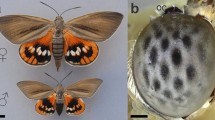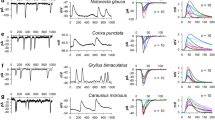Summary
Stimulus intensity-response relations (V-log I curves) were electrophysiologically (ERG) determined for the compound eyes of 46 lepidopteran species belonging to five different groups: butterflies (22 species), hesperids (3 species), diurnal sphingids (2 species), diurnal moths (3 species) and nocturnal moths (16 species). The V-log I curves were fitted to the Naka and Rushton equation,\(\frac{V}{{V_{max} }} = \frac{{I^n }}{{I^n + K^n }}\)in whichn represents the slope of the linear part of each curve. The slopes so determined range fromn=0.35 (the shallowest slope) in nocturnal moths with the greatest dynamic range ton=0.54 (the steepest slope) in diurnal moths andn=0.53 in butterflies both of which have narrow dynamic range. Hesperids (n=0.41) and diurnal sphingids (n=0.38) have intermediate values between butterflies and nocturnal moths.
The ratio of rhabdom to retinula volume is significantly higher in nocturnal moths (70–75%), however, those of butterflies and of diurnal moths are very small (2–5%), and hesperids and diurnal sphingids show intermediate ratio (ca. 25%).
The slopes of V-log I curves are inversely proportional to the ratio of rhabdom to retinula volume in the various eye types. In all groups except diurnal moths, the light intensities which produce maximal and saturated responses are nearly the same, therefore the nocturnal moths which have the lowest threshold to light increase their sensitivity to dim light mainly by decreasing the slopes of V-log I curves.
Similar content being viewed by others
References
Baylor DA, Fuortes MGF (1970) Electrical responses of single cones in the retina of the turtle. J Physiol 207:77–92
Bernhard CG, Ottoson D (1960a) Comparative studies on dark adaptation in the compound eyes of nocturnal and diurnal Lepidoptera. J Gen Physiol 44:195–203
Bernhard CG, Ottoson D (1960b) Studies on the relation between the pigment migration and the sensitivity changes during dark adaptation in diurnal and nocturnal lepidoptera. J Gen Physiol 44:205–215
Eguchi E (1978) Comparative fine structure of lepidopteran compound eyes, especially skippers (Hesperioidea). Zool Mag 87:32–43 (in Japanese)
Eguchi E (1982) Retinular fine structure in compound eyes of diurnal and nocturnal sphingid moths. Cell Tissue Res 223:29–42
Eguchi E, Waterman TH (1968) Cellular basis for polarized light perception in the spider crab,Libinia. Z Zellforsch 84:87–101
Eguchi E, Watanabe K, Hariyama T, Yamamoto K (1982) A comparison of electrophysiologically determined spectral responses in 35 species of Lepidoptera. J Insect Physiol 28:675–682
Exner S (1891) Die Physiologie der facettirten Augen von Krebsen und Insecten. Deuticke, Leipzig Wien
Fain GL, Dowling JE (1973) Intracellular recording from single rods and cones in the mudpuppy retina. Science 180:1178–1181
Fernández-Morán H (1958) Fine structure of the light receptors in the compound eyes of insects. Exp Cell Res Suppl 5:586–644
Höglund G, Struwe G (1971) Pigment migration and illumination of single photoreceptors in a moth. Z Vergl Physiol 74:336–339
Kawasoe A, Wakabayashi M (1975) Coloured illustrations of Japanese butterflies. Shirozu T (ed) (in Japanese) Hoikushu, Tokyo
Kleinschmidt J, Dowling JE (1975) Intracellular recordings from gecko photoreceptors during light and dark adaptation. J Gen Physiol 65:617–648
Lipetz LE (1971) The relation of physiological and psychological aspect of sensory intensity. In: Loewenstein WR (ed) Principles of receptor physiology. Springer, Berlin Heidelberg New York (Handbook of sensory physiology, vol 1, pp 191–225)
Loewenstein WR (1959) The generation of electrical activity in a nerve ending. Ann NY Acad Sci 81:367–387
Lythgoe JN (1972) The adaptation of visual pigments to the photic environment. In: Dartnall HTA (ed) Photochemistry of vision. Springer, Berlin Heidelberg New York (Handbook of sensory physiology vol VII/1, pp 566–602)
Matić T, Laughlin SB (1981) Changes in the intensity-response function of an insect's photoreceptors due to light adaptation. J Comp Physiol 145:169–177
Naka KI, Rushton WAH (1966a) S-Potentials from colour units in the retina of fish (Cyprinidae). J Physiol 185:536–555
Naka KI, Rushton WAH (1966b) S-potentials from luminosity units in the retina of fish (Cyprinidae). J Physiol 185:587–599
Nielsen ET (1963) Illumination at twilight. Oikos 14:8–21
Tsukahara Y, Horridge GA (1977a) Interaction between two retinula cell types in the anterior eye of the droneflyEristalis. J Comp Physiol 115:287–298
Tsukahara Y, Horridge GA (1977b) Miniature potentials, light adaptation and afterpotentials in locust retinula cells. J Exp Biol 68:137–149
Waterman TH (1981) Polarization sensitivity. In: Autrum H (ed) Comparative physiology and evolution of vision in invertebrates. Springer, Berlin Heidelberg New York (Handbook of sensory physiology, vol VII/6B, pp 281–469)
Wu CF, Pak WL (1978) Light-induced voltage noise in the photoreceptor ofDrosophila melanogaster. J Gen Physiol 71:249–268
Author information
Authors and Affiliations
Rights and permissions
About this article
Cite this article
Eguchi, E., Horikoshi, T. Comparison of stimulus-response (V-log I) functions in five types of lepidopteran compound eyes (46 species). J. Comp. Physiol. 154, 3–12 (1984). https://doi.org/10.1007/BF00605384
Accepted:
Issue Date:
DOI: https://doi.org/10.1007/BF00605384




